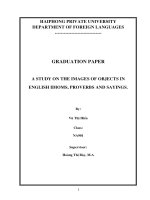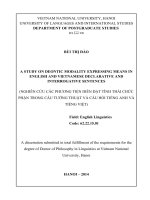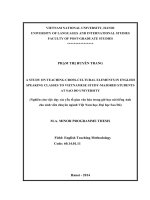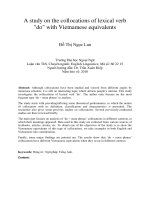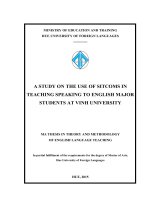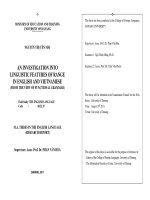A study on conceptual metaphor of dream in english and vietnamese songs (tt)
Bạn đang xem bản rút gọn của tài liệu. Xem và tải ngay bản đầy đủ của tài liệu tại đây (356.82 KB, 26 trang )
THE UNIVERSITY OF DA NANG
UNIVERSITY OF FOREIGN LANGUAGE STUDIES
CHÂU NGỌC THẠCH ANH
A STUDY ON CONCEPTUAL METAPHOR OF
“DREAM” IN ENGLISH AND VIETNAMESE SONGS
Major: ENGLISH LINGUISTICS
Code: 8220201
MASTER THESIS
IN FOREIGN LANGUAGES, LITERATURE AND CULTURE
(A SUMMARY)
Da Nang, 2018
This thesis has been completed at University of Foreign Language
Studies, The University of Da Nang
Supervisor: TRẦN QUANG HẢI, Ph.D
Examiner 1: Assoc. Prof. Dr. HỒ THỊ KIỀU OANH
Examiner 2: Assoc. Prof. Dr. LÂM QUANG ĐÔNG
The thesis was be orally defended at the Examining Committee
Time: October 27th, 2018
Venue: University of Foreign Language Studies
-The University of Da Nang
This thesis is available for the purpose of reference at:
Library of University of Foreign Language Studies,
The University of Da Nang.
1
Chapter one
INTRODUCTION
1.1. RATIONALE
Cognitive linguistics is a new approach that explores “the
relationship between human language, the mind and socio-physical
experience” (Evans et al., 2007). One of the aspects, which cognitive
have stressed most, is the importance of metaphor in language, and it
is considered an essential and indispensable phenomenon in both
language and thought.
As a result, the study of cognitive metaphor or conceptual
metaphor has become one of the greatest concerns of linguistics
around the world. A lot of researchers investigated conceptual
metaphor in poems, tales or advertisements. Others studied conceptual
metaphor of specific words or expressions such as “love”, “life”,
“spring” and so on.
However a detailed study of cognitive metaphor of “dream” in
English and Vietnamese songs has not been dealt with so far. The word
“dream” appears a lot in songs in which the lovers express their
emotion, their feeling, their expectation.
Let us consider the excerpt taken from the song “The dream” of
band Secret Garden.
A dream we carry with us
And the hopes that we hold
As we rise from the ash into gold
We reach for the impossible
As unreal it may seem
Still we sail 'cross the ocean
And follow the dream
2
In the above cases, “dream” is understood as something that we
can carry and follow. The use of ontological metaphor enables people
to talk about and understand “dream” as a physical entity.
Another excerpt from Vietnamese song “Giấc mơ thu về” of
Quang Minh. “Dream” is also treated as a discrete entity such as cloth
or flowers that can be weaved. This is also a kind of structure metaphor
in Vietnamese.
Một cánh sao rơi chìm đêm tăm tối
Muôn kiếp đơn côi giá băng hồn tôi
Người đi đã mấy thu rồi sao tôi dệt mãi giấc mơ
Thời gian chưa phai nhung nhớ
Người ơi tuy duyên đã lỡ
Hãy về sưởi ấm tim côi
With the deep concern with conceptual metaphor and the romantic
word “dream”, especially on the basis of the results of the previous
studies, I decided to carry out the study entitled: “A study on conceptual
metaphor of “dream” in English and Vietnamese songs”.
Last but not least, I hope my small contribution will help
Vietnamese learners of English to have deeper understanding about
conceptual metaphor of “dream” in songs.
1.2. AIMS AND OBJECTIVES
1.2.1. Aims
The aim of this study is to examine the conceptual metaphor of
“dream” in English and Vietnamese songs in the light of cognitive
linguistics. It also discovers and explains the similarities and
differences of conceptual metaphors of “dream” in English and
Vietnamese song. Also, this study will be a useful reference for those
who are interested in conceptual metaphors in songs
3
1.2.2. Objectives
To achieve the aims of the study, the following objectives are
intended to:
- Analyze the conceptual metaphors of “dream” in English and
Vietnamese songs.
- Discover and explain the similarities and differences of
conceptual metaphors of “dream” in English and Vietnamese songs.
- Make some suggestions for teaching, learning, and translating
conceptual metaphors of “dream” in English and Vietnamese songs.
1.3. SCOPE OF THE STUDY
In this research, we just investigate the conceptual metaphors of
“dream” in songs in the light of Cognitive linguistics. We also try our
best to find out the similar and different expressions of conceptual
metaphors of “dream’ in English and Vietnamese songs in terms of the
Cognitive linguistic frame. The corpus source for this research is
chosen from publications and collections in English and Vietnamese.
1.4. RESEARCH QUESTIONS
In order for all the aforementioned aims and objectives to be
achieved, the following research questions are put forward:
1. What are the conceptual metaphors of “dream” in English songs?
2. What are the conceptual metaphors of “dream” in Vietnamese songs?
3. What are similarities and differences of conceptual metaphor
of “dream” in English and Vietnamese songs?
1.5. SIGNIFICANCE OF THE STUDY
This study has attempted to investigate conceptual metaphors of
“dream” in English and Vietnamese songs, the results of the study is
hoped
to make certain contributions to existing knowledge of
conceptual metaphors. The study will also help learners understand the
4
similarities and differences of English and Vietnamese cultures in the
use of conceptual metaphors of “dream”. Additionally, the findings are
supposed to be a useful source for English learners who are interested
in conceptual metaphors of “dream” in English and Vietnamese songs
1.6. ORGANIZATION OF THE STUDY
This study will consist of 5 main chapters as follows:
Chapter 1: Introduction
Chapter 2: Literature Review and Theoretical background
Chapter 3: Method and Procedures
Chapter 4: Finding and Discussions
Chapter 5: Conclusion and Implications
5
Chapter Two
LITERATURE REVIEW AND THEORETICAL
BACKGROUND
2.1. LITERATURE REVIEW
Regarding research in conceptual metaphor, so far a vast
number of studies have been carried out. As a starting point with Dana
Retová (2008), she studies conceptual metaphors related to the the
concepts of six emotions: anger, fear, happiness, sadness, pride, and
shame.
In addition, Emma Gavelin (2015) investigated conceptual
metaphors of LOVE in two albums by singer Mariah Carey. It also
includes an investigation of if LOVE metaphors were used differently
at the beginning of her career from how they are used twenty-four
years later. The results also showed that the source concept which was
most typically used overall was also reflected to describe the target
concept in both albums.
Meanwhile, Rebekah Beyer from Western Oregon University
(2000) explored the conceptual metaphors expressed in children’s
literature using Lakoff and Johnson’s theoretical framework. The
results indicated a strong presence of metaphoric expressions in
children’s literature.
In Vietnam, there are several research papers on conceptual
metaphors in term of cross-linguistic studies in English and
Vietnamese. Nguyễn Hoàng Nam (2012) focused on analyzing the
semantic features of English and Vietnamese idioms denoting human
feelings in terms of happiness, sadness, anger and fear.
Nguyễn Thị Hồng Phúc (2013) investigated the conceptual
metaphors of women in The Tale of Kieu and Its English Version
6
The study done by Nguyễn Thị Thơm (2010) discussed the
nouns “love” on some English expressions.
Available literature reveals that a lot of researches has been done
on conceptual metaphor. However, the existing studies have not paid
much attention to conceptual metaphor of “dream”, especially in
English and Vietnamese songs. For this reason, I decided to investigate
conceptual metaphor of “dream” in English and Vietnamese songs.
2.2. THEORETICAL BACKGROUND
2.2.1. Cognitive linguistics
Cognitive linguistics which originally emerged in the 1970s is
the scientific study concerned with investigating the relation of
language structure to things outside. It is a modern school of linguistic
thought and practice, which Fauconnier and Turner (1998:133) refer
as “a powerful approach to the study of language, conceptual systems,
human cognition, and general meaning construction”.. Cognitive
linguistics practice could be roughly divided into two main areas of
research: cognitive semantics and cognitive grammar.
2.2.2. Cognitive grammar
Evans & Green (2006:50) adopt the viewpoint that cognitive
approaches to grammar refer to “the study of the symbolic linguistic
units that comprise language”.
2.2.3. Cognitive Semantics
2.2.3.1. Definition of cognitive semantics
Cognitive semantics is part of cognitive linguistics. According
to Evans (2006), cognitive semantics is concerned with the
investigating the relationship between human experience, the
conceptual system in human mind, and the semantic structure encoded
by language. In the light of this, scholars studying in cognitive
7
semantics
investigate
knowledge
representation
(conceptual
structure), and meaning construction (conceptualization).
2.2.3.2. Main tenets of cognitive semantics
As summarized by Evans and Green (2006:157), there are four
guiding principles that collectively characterize cognitive semantics as
follow:
- Conceptual structure is embodied
- Semantic structure is conceptual structure
- Meaning representation is encyclopedic
- Meaning construction is conceptualization.
2.2.4. Conceptual Metaphor Theory
2.2.4.1. Traditional view of metaphor
Lakoff and Johnson (1980) indicated that metaphor for most
people is a device of poetic imagination and the rhetorical flourish – a
matter of extraordinary than ordinary language. Moreover metaphor is
typically viewed as characteristic of language alone, a matter of word
rather than thought or action. For this reason, most people think they
can get along perfectly well without metaphor
2.2.4.2. Conceptual metaphor
In the cognitive linguistic view, a conceptual metaphor (Lakoff,
1980) is defined as a tool which allows us to understand one
conceptual domain in terms of another. Cognitive metaphors help us
to understand complex and abstract concepts in terms of simpler ones
(Lakoff & Johnson, 1980; Forceville, 2006).
According to Lakoff and Johnson (1980), metaphor exists
everywhere and plays an important role in everyday life.
2.2.4.3. Classify conceptual metaphor
According to Lakoff and Johnson, metaphors can be divided
8
into three basic subtypes: ontological metaphor, structural metaphor,
and orientational metaphor.
a. Structural metaphor
In structural metaphors, rich structure knowledge is provided by
the source domain for the target concept. By the structure of the source,
the speakers are able to understand the target. The understanding
process happens when the elements of the source are conceptually
mapped onto the elements of the target (Kövecses, 2002).
b. Orientational metaphors
Most orientational metaphors are related to basic spatial
orientations of human beings, such as up-down, center-periphery, and
so on. The cognitive function of orientational metaphor is a series of
target concepts coherent in our conceptual system. It could sometimes
be called a “coherence metaphor”.
c. Ontological metaphors
Ontological metaphors can also be understood as entity and
substance metaphors (Lackoff & Johnson 1980). Ontological
metaphors are based on our experience with the physical world around
us. When things we want to refer to are not very concrete and do not
have a clear physical shape, we tend to understand them as entities or
substances. This means that we can “refer to them, categorize them,
group them, and qualify them” (Lakoff & Johnson 6, 1980).
2.2.4.4. Personification
Personification can also be conceived as an extension of
ontological metaphors, for the reason that the source domain is
furthered specified as a person and human characteristics are applied
to nonhuman entities (Lackoff & Johnson, 1980).
2.2.4.5. Metaphoric Mappings
Metaphoric Mappings according to Lakoff and Turner (1989),
9
is a mapping from one conceptual domain to another. It has a threepart structure: two endpoints (the source and target schemas) and a
bridge between them (the detailed mapping).
- Mapping Principles According to Lakoff (1980), metaphor is a
cross-domain mapping in the conceptual system. The convention is to call
each mapping as “TARGET-DOMAIN IS/AS SOURCE-DOMAIN”
Mapping Types There are two main kinds of mappings:
conceptual mappings and image mappings.
10
Chapter Three
RESEARCH DESIGN AND METHODOLOGY
3.1. METHODOLOGY
In order to achieve the aim, this study makes use of both
qualitative and quantitative research design employing descriptive and
contrastive analysis method.
3.2. SAMPLING
In order to build up the data of the study, I collected data based
on the following criteria:
- The samples have to be related to “dream”.
- The samples have to be extracted from English and
Vietnamese songs from twentieth century till now.
- Samples in English is from Western countries.
- The sources where samples are collected could be credible.
With such criteria, I collected about 281 samples randomly
including 143 in English and 138 in Vietnamese from the reliable
websites on the Internet for the corpus of English and Vietnamese
songs which were suitable for the study.
3.3. DATA COLLECTION
To conduct this research, about 281 samples (143 in English and
138 in Vietnamese) were mainly collected from 114 English and 126
Vietnamese songs from Internet.
3.4. DATA ANALYSIS
Having chosen Lakoff and Johnson’s Conceptual Metaphor
11
Theory and Kovecses as the model of linguistic expressions of
Metaphor.
On the basis of about 281 samples collected, data analysis was
carried out following these steps:
- Collecting relevant materials and necessary data from several
sources
- Investigating cognitive metaphors of “dream” in English and
Vietnamese songs based on the theory of cognitive semantics.
- Discovering and explaining the similarities and the differences
in cognitive metaphors of “dream” in English and Vietnamese songs.
- Suggesting some implications for teaching, learning and
translating conceptual metaphors and for further researches.
3.5. RELIABILITY AND VALIDITY
In term of reliability, the songs used for analysis were mainly
taken from the collection of famous songs by well-know composers as
well as from the official sites on the Internet. The data from the Internet
was mainly exploited form the websites of the well – known
organizations. Moreover, the findings and conclusions in the study
were drawn from the analysis of the number and the frequency of
samples and proofs concerned without any prejudices and
presuppositions. For this reason, the objectivity of the study is assured.
In term of validity, the analyses in the study have always been
conducted in the light of theoretical background to ensure the quality
of the study.
12
Chapter Four
FINDINGS AND DISCUSSIONS
4.1. CONCEPTUAL METAPHOR OF “DREAM”
With the efford of finding some metaphoric source domains
mapping with the target domain “dream”, the investigation found out
14 source domains after collecting and analyzing corpus: HUMAN
BEING, PERSONAL POSSESSION, HAPPINESS, SADNESS,
OBJECT, CONTAINER, PRODUCT, BIRD, LIQUID, COLOR,
LOVE/LOVER, ICE, CLOTH, LEADER.
Table 4.1. Frequency of types of conceptual metaphors denoting
“dream” in English and Vietnamese songs.
Occurrence
Conceptual
Structural
Ontological
Orientational
metaphors
metaphors
metaphors
metaphors
E
V
T
E
V
T
25
13
38
23
28
51
DREAM IS
HUMAN
BEING
DREAM IS
PERSONAL
13 10
23
8
8
16
5
4
9
POSSESSION
DREAM IS
HAPPINESS
DREAM IS
SADNESS
DREAM IS
E
V
T
13
Occurrence
Conceptual
Structural
Ontological
Orientational
metaphors
metaphors
metaphors
metaphors
E
V
T
E
V
T
32
28
60
1
23
24
7
2
9
E
V
T
OBJECT
DREAM IS
CONTAINER
DREAM IS
PRODUCT
DREAM IS
BIRD
DREAM IS
LIQUID
DREAM IS
COLOR
9
0
9
3
5
8
4
4
8
4
7
11
DREAM IS
LOVE/LOVER
DREAM IS
ICE
DREAM IS
CLOTH
4
4
8
5
2
7
DREAM IS
LEADER
Total
99
182
%
35.23
64.77
Table 4.1 shows the Classification and occurrence of conceptual
metaphors denoting “dream" in both languages. Noticeably,
14
ontological metaphors are found in songs with the highest occurrence,
making up 64.77 % of all three subtypes. Structural metaphors account
for 35.23% and the no orientational metaphor is founded. The
following part will present the thorough analysis of these subtypes.
4.1.1. DREAM IS CONTAINER
The abstract concept “dream” is metaphorically understood as a
container when it combines with the preposition such as “in”, “inside”,
“within” and the verb “fill”.
(4.1)
You were in my dreams
Always in my dreams
That was long before
I ever saw you standing there[4.4]
(4.9)
Em đã sống trong những giấc mơ
Sống trong từng nghĩ suy của anh
Và đôi khi em hay giấu lòng mình
Những lúc buồn cần anh âu yếm. [4.18]
4.1.2. DREAM IS HUMAN BEING
“Dream” is understood as a human being which is given human
qualities.
(4.15)
I get down from a bad dream
When it’s gone
Worse dreams are born [4.67]
(4.26)
Giấc mơ nay đã chẳng còn xa xôi nơi đâu
Giờ đang đứng mỉm cười với ta
Mênh mông sao trời không gian yên lặng
Nghe con tim mình lên tiếng. [4.91]
4.1.3. DREAM IS OBJECT
We regard this vague concept as a kind of concrete entity which can
be able to interact in physical way and even cause events in the world.
15
(4.31)
Love laughs at a king
(4.45)
Kings don't mean a thing
On the street of dreams
Dreams broken in two can be made like new [4.99]
Giờ thì em đã biết mất anh đau thế nào
Biết cô đơn sẽ như thế nào
Đến đây, hãy đến để khẽ hôn em và nói yêu thương
Dù rằng em đã biết giấc mơ vỡ tan rồi [4.137]
4.1.4. DREAM IS A PERSONAL POSSESSION
Each person always considers “dream” as his or her own things.
Therefore possessive adjectives and possessive verbs such as “my”,
“have”, “get” tend to be put before the abstract noun of “dream”, in
order to show their ownership:
(4.51)
Climb every mountain,
Ford every stream,
Follow every rainbow,
'Till you find your dream[4.153]
(4.54)
Giấc mơ tuổi thơ của tôi,
Là tiếng võng đưa hè trưa, mẹ ru
Cánh diều mang tuổi thơ,
Nhẹ tung cánh bay giữa trời gió và mây. [4.167]
4.1.5. DREAM IS HAPPINESS
“Dream” is understood as happiness when it is combined with
the adjective, such as “nice”, “sweet”, “happy”.
4.57)
Every night I go through
Why can't I forget you?
And start my life a new
Instead of having
Sweet dreams about you[4.173]
16
Đêm mơ, giấc mơ ngày hôm qua.
Giấc mơ bình yên, giữa đêm mùa đông
Giấc mơ nào của tôi, giấc mơ nào cho ai
Giấc mơ nào để quên
Tôi lặng im, ngắm những giấc mơ [4.185]
4.1.6. DREAM IS SADNESS
This type of conceptual metaphor can be found when “dream”
combines with the negative adjectives like “bad”, “rough”, “troubled”,
“Shattered”.
4.67)
I get down
From a bad dream
When it’s gone
Worse dreams are born
Spinning you around in a fire
By the old one and free[4.192]
4.1.7. DREAM IS LOVE/LOVER
Love is understood as a strong feeling of affection and sexual
attraction for someone. “Dream” is seen as love or lover when it
collocates with the words such as “yêu”, “đắm say”, “ôm”, “nhớ
thương”, “say nắng”, “níu kéo”,
(4.77)
I'll take your dream and crush it
Does the truth ever rain?
From the manic clouded mind
High on their thrones
Incapable, unkind [4.198]
(4.71)
Ở đây mưa buồn
Nắng phương xa lại đang nhớ thương giấc mơ còn vấn vương
Nụ cười ai sao quá ngây thơ
Dù yêu xa thật khó
Dù tình em ra khơi, [4.201]
(4.63)
17
4.1.8. DREAM IS PRODUCT
When we mention DREAM IS PRODUCT, we mean the
activities referring to product such as “sell”, “trade”, “buy”, “make”,
“use”, “waste” and adjectives like “precious”, “worthless”:
(4.78)
Midnight, you heavy laden, it's midnight
Come on and trade in your old dreams for new
Your new dreams for old
I know where they're bought [4.226]
4.1.9. DREAM IS COLOR
About 4 in the total of 200 metaphorical expressions denote
DREAM IS COLOR in English. Most expressions describe the colorfade through time
(4.84)
Or will this dream of mine
Fade out of sight
Like the moon glowing dim
On the rim of the hill
In the chill, in the still of the night[4.232]
(4.87)
Bao ngày qua bên em trong phút giây êm đềm
Mong thời gian sẽ mãi ngừng trôi người ơi!
Nhưng giờ người nơi đâu cho giấc mơ phai màu
Đêm từng đêm em vẫn thầm nhớ...về em [4.241]
4.1.10. DREAM IS LIQUID
“Dream” is seen as a liquid when it combines with the verbs
such as “drown”, “flow”, “sink”.
(4.90)
Just to keep me from losing my mind
Thoughts turn to a love so kind
Just to keep me from losing my mind
So enticing, deep dark seas
It's so easy to drown in the dream[4.242]
18
(4.93)
Một giây anh chìm vào cơn mơ, những ngọt bùi ngu
ngơ ta đã từng
Và một giây anh chạnh lòng bơ vơ, với nụ cười bâng
quơ anh sẽ dừng lại
Cho em đi tiếp, mình chẳng còn bên nhau tha thiết
Đành mang giấc mơ bấy lâu nay bỏ lại đây [4.246]
4.1.11. DREAM IS BIRD
“Dream” is conceived in terms of a bird in both languages. The
American use the verbs such as “fly”, “take wings” show the motion
of bird.
(4.97)
This joy is something new my arms enfolding you,
Never knew this thrill before
Whoever thought I'd be holding you close to me
whispering you I adore
Dearest one if you should leave me
Each little dream would take wing and my life would
be through [4.250]
(4.100) Dù anh biết những lời thề xưa
Tựa giấc mơ bay xa rồi
Đừng nên thương tiếc
Đừng nên chua xót
Để cho trái tim này đớn đau [4.253]
4.1.12. DREAM IS ICE
“Dream” is comprehended as melting ice in when it combines
with the verb “melt”
(4.102) In the distance
Coming to change my plans
All my dreams will melt like sand
Dreams can melt in the sky [4.259]
19
(4.104)
Giấc mơ chỉ còn lại mưa trên đường mưa
Giấc mơ tan thành mưa ướt vai áo se lạnh
Từng giây phút yêu thương anh giữ trong tim sẽ không
bao giờ tan biến
Vì anh nhớ mưa trên con đường mưa [4.263]
4.1.13. DREAM IS CLOTH
The abstract concept of “dream” is metaphorically understood
as cloth when it combines with the words “weave”, “weaver”.
(4.105)
My world would be a beautiful place
Where we would weave such wonderful dreams
My world would wear a smile on its face
Like the man in the moon when the moon beams [4.266]
(4.107)
Một cánh sao rơi chìm đêm tăm tối
Muôn kiếp đơn côi Giá băng hồn tôi
Người đi đã mấy thu rồi Sao tôi dệt mãi giấc mơ [4.272]
4.1.14. DREAM IS LEADER
“Dream” is characterize as a leader which people follow or chase
(4.108)
I've got to follow that dream wherever that dream may lead
I've got to follow that dream to find the love I need[4.273]
(4.111)
Sông trôi phía xa vời
Theo giấc mơ biển khởi
Mang theo bóng chim trời
Như tiếng ru lòng tôi
Còn lại nụ cười người qua chuyến đò ngang [4.281]
20
4.2. DISCUSSION OF FINDING
4.2.1. Similarities in conceptual metaphor of “dream” in
English and Vietnamese songs
Table 4.2. Frequency of conceptual metaphors for “dream” in English
and Vietnamese songs
STT
1
2
3
4
5
6
7
8
9
10
11
12
13
14
CONCEPTUAL
ENGLISH
METAPHOR
DREAM IS
HUMAN
BEING
DREAM
IS
PERSONAL
POSSESSION
DREAM IS
HAPPINESS
DREAM IS
SADNESS
DREAM IS
OBJECT
DREAM IS
CONTAINER
DREAM IS
PRODUCT
DREAM IS
BIRD
DREAM IS
LIQUID
DREAM IS
COLOR
DREAM IS
LOVE/LOVER
DREAM IS
ICE
DREAM IS
CLOTH
DREAM IS
LEADER
%
VIETNAMESE
%
Total
25
17%
13
9%
38
13
9%
10
7%
23
8
6%
8
6%
16
5
3%
4
3%
9
23
16%
28
20%
51
32
22%
28
20%
60
9
6%
0
0%
9
3
2%
5
4%
8
4
3%
4
3%
8
4
3%
7
5%
11
1
1%
23
17%
24
4
3%
4
3%
8
5
3%
2
1%
7
7
5%
2
1%
9
143
100%
138
100% 281
21
The aspect of a conceptual metaphor consists of correspondences
between a source domain and a target domain. From careful analyses
in the previous chapter, we can conclude that most of metaphors are
found in both American and Vietnamese songs. Both languages share
the same conceptualization of “dream” when considering “dream” as
“container, object, happiness, sadness, human being, personal
possession, liquid, bird, color, ice”.
4.2.2. Differences in conceptual metaphor of “dream” in
English and Vietnamese songs
It is clear that the conceptual metaphors “dream” are also
applied differently in English and Vietnamese in some aspects. These
differences will be presented and explained as follows.
Based on the total number of love expressions, we can conclude
that the conceptual metaphors denoting “dream” in American
outnumber that in Vietnamese.
Regarding the ontological metaphors, noticeable differences
between the two languages are related to the metaphor DREAM IS
HUMAN BEING. Despite some similarities mentioned above, it is
noticed that in English, the words denoting the life and death of
“dream” is mentioned regularly such as “alive”, “survive”, “die” ,
“born”, “fly to heaven”, “kill”. Whereas Vietnamese avoid using
words related to the death and use adjectives describe emotion of
“dream” such as “cô đơn”, “dịu dàng”, “buồn”.
Regarding the structural metaphors, DREAM IS PRODUCT
metaphor only occur in English data
Last but not least, it seems that conceptual metaphor DREAM
IS LOVE/LOVER may be better developed in Vietnamese than in
English.
22
4.2.3. Explanation the differences
It is clear that language and culture have mutual affection. Many
researches explored the connection between language and culture
The differences between cultures result in the differences in
using the conceptual metaphor. Many researches explored the
connection between language and culture. Kramsch (1998) claimed
that language expresses, embodies and symbolizes cultural reality
clearly show that language and culture are bounded together. Brown
(1994) argued that “A language is a part of a culture and a culture is a
part of a language; the two are intricately interwoven so that one cannot
separate the two without losing the significance of either language or
culture”. Trần Ngọc Thêm (1999) also claims that American and
Vietnamese, to some extent, have different attitudes and perception
towards many aspects of life.
4.3. CONCLUDING REMARKS
From analyzing conceptual metaphors of dream in English and
Vietnamese songs in the light of cognitive semantics, the similarities
and the differences in the expression of these conceptual metaphors
have been examined and discussed. Besides, culture has been
considered a factor to form the different conceptual metaphors of
dream in English and Vietnamese songs.
23
Chapter Five
CONCLUSION AND IMPLICATION
5.1. SUMMARY OF MAJOR FINDINGS
Within the approach of contrastive analysis using qualitative
method of data analysis, my study investigated conceptual metaphors
of “dream” in English and Vietnamese songs under the light of
Conceptual Metaphor Theory (Lakoff & Johnson, 2003. 280
metaphorical expressions selected from English and Vietnamese songs
were classified into 14 subcategories: DREAM IS HUMAN BEING,
DREAM IS PERSONAL POSSESSION, DREAM IS HAPPINESS ,
DREAM IS SADNESS, DREAM IS OBJECT, DREAM IS
CONTAINER, DREAM IS PRODUCT, DREAM IS BIRD , ,DREAM
IS LIQUID, DREAM IS COLOR , DREAM IS LOVE/LOVER,
DREAM IS ICE , DREAM IS CLOTH, DREAM IS LEADER.
Furthermore, from the analysis above, the similarities and
differences in the expressions of conceptual metaphors of dream are
pointed out. For example, DREAM IS PRODUCT exist only in
English and DREAM IS LOVE OR LOVER is employed commonly
in Vietnamese, only one is found in English.
5.2. IMPLICATIONS FOR THE STUDY
5.2.1. Implications for teachers
Firstly, teachers should apply this theory in curriculum to help
their students understand more about conceptual metaphors. Secondly,
the collocation of words can be explained reasonably by metaphors.
Thirdly, teachers should notice that there are also metaphorical
expressions which are based on ontological metaphor of DREAM IS
OBJECT. Lastly, orientational metaphor which reflects the different
